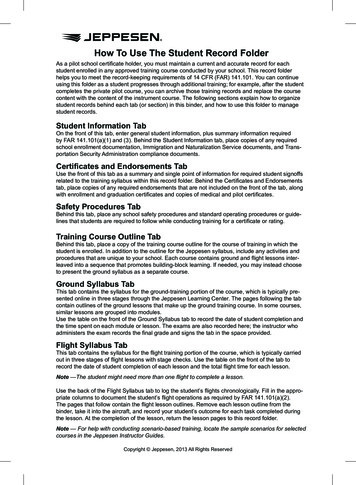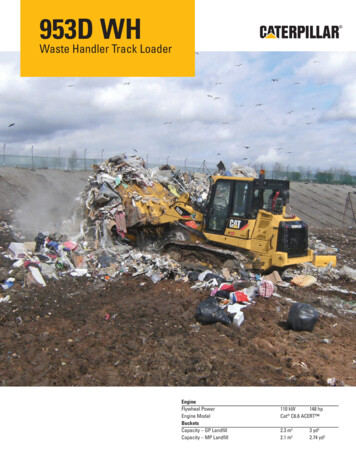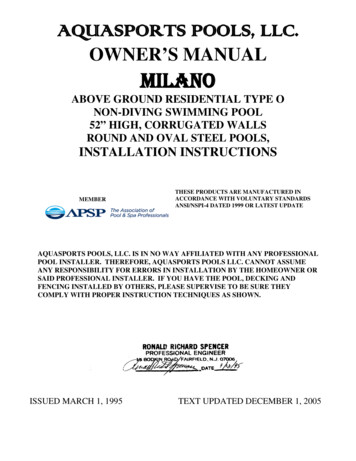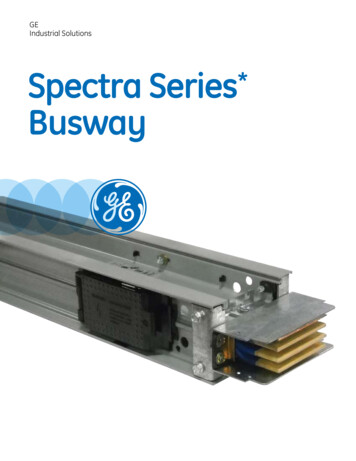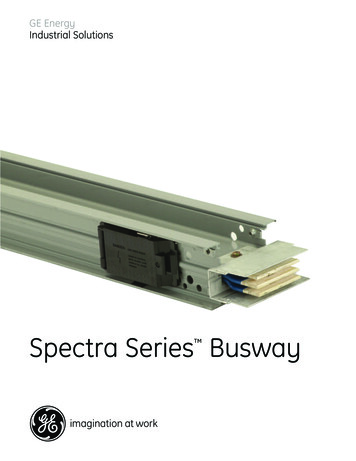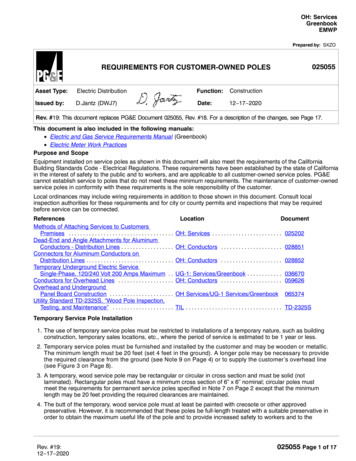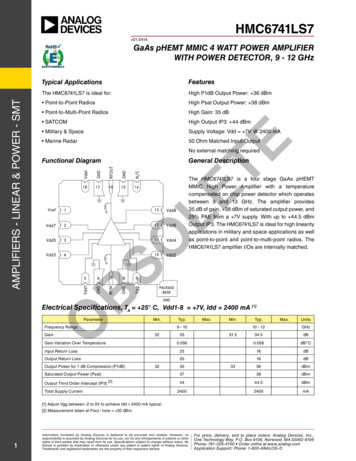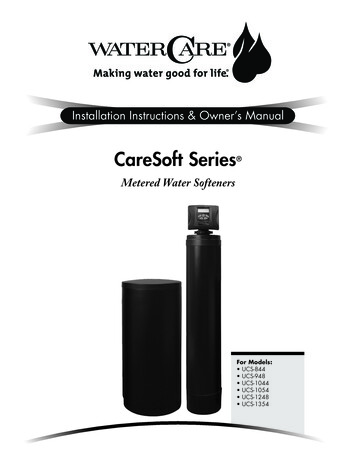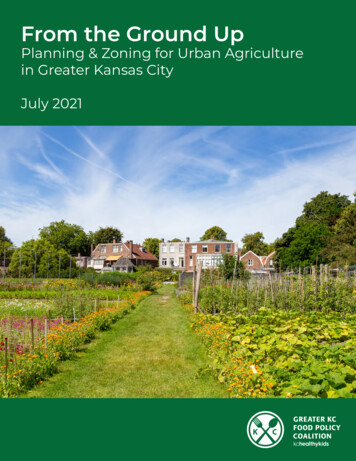
Transcription
From the Ground UpPlanning & Zoning for Urban Agriculturein Greater Kansas CityJuly 2021
About UsContact UsThe Greater KC Food Policy Coalition is a community-basedinitiative, functioning as a program within KC Healthy Kids,that engages leaders and stakeholders from all criticalcomponents of the regional food system to advocate for goodfood policies that positively impact the nutritional, economic,social and environmental health of the g@KCHealthyKidsThe coalition established the Urban Farm Zoning and Planning Task Force in April 2020 toidentify best practices and develop policy recommendations to ensure urban farmers are able tooperate successfully.KC Healthy Kids advances the health and well-being of children and families throughcommunity-driven initiatives and advocacy where they live, learn, work and play.Thank YouWe would like to extend our deepest gratitude to task force members, interns, volunteers andstakeholders for sharing their time and expertise. This report was made possible by the generousfinancial support of Health Forward Foundation.KC Healthy KidsTask Force MembersBeth Low-SmithVice President, PolicyGreater KC Food Policy Coalition, DirectorMark GawronCultivate KCGreater KC Food Policy Coalition, Steering CommitteeAndrea ClarkPolicy and Planning ManagerKate GiesselAttorneyGreater KC Food Policy Coalition, Vice ChairpersonSarah HofmeyerPlanning InternSarah DavisPlanning InternKat TownsendPlanning VolunteerTeresa KellyKC Food HubNeil RudisillIvanhoe Neighborhood CouncilWoodland City KC Urban FarmDre TaylorNile Valley AquaponicsThe KC Urban Farm Co-OpPatrick TroubaMid-America Regional Council
Table of Contents1Dig Into Urban Agriculture123About this ReportAbout Urban AgricultureBenefits of Urban Agriculture4 Plan for Urban Agriculture57Planning PracticesPlanning Resources8 Overcome Barriers9111315161820Cultivate Vacant LotsConserve Agricultural LandTap into Water AccessPermit Urban AgricultureAllow Accessory StructuresSupport Farm-to-MarketClarify Policies & Processes21 Appendices21 A: Glossary of Terms23 B: Research & Engagement
Dig Into Urban AgricultureAbout this ReportThis report is the result of a year of work led by the Urban Farm Zoning and Planning Task Force,an initiative of the Greater KC Food Policy Coalition. It is a tool for urban planners, city staff, urbanfarmers and advocates to use to address the biggest barriers to urban agriculture in the KansasCity region. It will inform the coalition’s work to advocate for policy change.Review the Agenda: Greater KC Food Policy Coalition 2020-2023 Policy AgendaTo better understand the barriers urban farmers face relatedto planning and zoning, the task force: Reviewed local plans and zoning ordinances. Surveyed local urban farmers and urban planners. Facilitated public meetings and expert interviews. Explored policies and resources for urban agriculture.The first section of this report gives an overview of urbanagriculture and its benefits. The second section providesbest practices and resources to plan for urban agriculture.The third section outlines seven barriers and offers policyrecommendations and case studies to support urbanagriculture.Project TimelineApril 2020Establish task forceMay 2020Research and engagementJune 2021Present researchSelect coalition prioritiesJuly 2021Publish reportAugust 2021Develop advocacy planSeptember 2021Advocate for changeCreate policy resources1
About Urban AgricultureUrban agriculture, in general terms, is the production of food in urban and peri-urban areas.Urban agriculture ranges in scale and intensity from community gardens to commercial urbanfarms. It encompasses a variety of production methods, like no-till farming and hydroponics. Itincludes keeping bees and raising fish, poultry and livestock.Urban agriculture is not just production, but also the processing, distribution, sale and reuse oflocally grown food. Products like produce, honey, eggs, dairy and meat are grown for personalconsumption, donated to food banks, sold at markets and served at restaurants.Valentine Community GardenSplitlog Farm and OrchardWoodland City KCTalking Tree UrbanFarm2
Reap the BenefitsUrban agriculture has been shown to improve overall wellbeing, foster community and generatesocial capital. It benefits our food system, health, climate and economy.Learn the Benefits: Urban Agriculture Impacts: Social, Health and EconomicStabilizes Food SystemsRecent disruptions like the COVID-19 pandemicand the effects of climate change have revealedjust how fragile our global food system is. Tostrengthen our regional food system, mitigatethe impact of future disruptions and ensurecommunity food security, we must support localfood production, including urban agriculture.The Food SystemReuse &DisposeProduce & ProcessDistributeCultivates Climate ResiliencyAs noted in the Kansas City Regional ClimateAction Plan, local and sustainable agriculture isConsumePurchaseone way to cultivate a resilient climate. Locallygrown food travels fewer miles from farm to fork,reducing greenhouse gas emissions. Regenerative agriculture, based on Indigenous knowledgeand practices, nurtures the soil, sequesters carbon and enhances biodiversity. Urban agriculture,as a form of green infrastructure, can also reduce stormwater runoff.Read the Plan: KC Regional Climate Action PlanGrows Local EconomiesFrom farm stands to farm-to-table restaurants, food and farm businesses keep money in our localeconomy. Community food projects such as incubator farms, community kitchens and farmersmarkets provide training, create jobs, grow small businesses and expand markets for farmers.Explore the Map: Eat Local KC Map3
Plan for Urban AgricultureUrban agriculture tends to be an afterthought for planning and zoning. A statement aboutcommunity gardens may appear in a parks master plan and regulations for farmers markets mayget added to a zoning ordinance, but comprehensive planning for urban agriculture is lacking inthe Kansas City region.In our survey, 47% percent of urban planners thought urban agriculture was a moderate priorityfor their city. But 53% of urban planners said that efforts to address urban agriculture in theircity’s long-range plan had been unsuccessful. Seventy-seven percent reported that their citydidn’t have an urban agriculture ordinance. Currently, the City of Kansas City, Missouri is the onlymunicipality in the region that has adopted an urban agriculture ordinance, but it hasn’t beenupdated in a decade. It is no surprise that urban farmers continue to encounter barriers.Read the Ordinance: City of Kansas City, Missouri Urban Agriculture Ordinance12%6%18%24%Is urbanagriculture apriority in yourcity?24%12%18%Does your cityaddress urbanagriculture in thecomprehensiveplan?12%12%Does your cityhave an urbanagricultureordinance?47%53%Not a priorityLow priorityModerate priorityHigh priorityNo, and no effortsNo, but efforts madeYes, but no goalsYes, and includes goals465%I don't knowNo, and no effortsNo, but efforts madeYes
Planning PracticeUrban planners have the professional skills as well as access to a variety of tools to help eliminatesome of the challenges urban farmers face or make them more manageable to overcome. Hereare some best practices to use when planning for urban agriculture.Conduct an InventoryMap urban agriculture assets and activity inyour city. Almost 40% of urban planners saidthey weren’t very aware of urban agriculturegoing on in their city. Having this informationwill help plan for urban agriculture. Identify school and community gardens,urban farms and orchards, farmers marketsand food hubs. Review land use maps, long-range plansand zoning ordinances to identify barriers tourban agriculture. Locate suitable vacant lots, public land orprime farmland for urban agriculture.Farm Tour at Woodland City KCEngage Urban FarmersCommunity engagement is vital to long-range planning. Just 31% of urban planners saidthey could identify urban agriculture stakeholders in their community. About 40% said theydon’t engage urban farmers in long-range planning, and 30% weren’t sure. Here are someorganizations across the region that work to bring urban farmers to the table and get urbanplanners to the farm: Cultivate KC Growing Growers Kansas City Community Gardens National Young Farmers Coalition University Extension Services6%0%11%31%33%I am aware ofcurrent urbanagricultureactivities.31%29%I can identifykey stakeholdersin urbanagriculture.My city engageskey stakeholdersin urbanagriculture inlong-rangeplanning.38%41%50%Strongly agreeSomewhat agreeSomewhat disagreeStrongly disagree29%Strongly agreeSomewhat agreeSomewhat disagreeStrongly disagree5YesNoI don't know
Communicate ClearlyUrban agriculture and urban planning each have their own professional jargon, and clearcommunication between stakeholders is fundamental to all other planning goals. Withoutconsensus on terms, it’s difficult to clearly develop, follow and enforce policies. Define technical urban planning and urban farming terms in plain language. Make information about plans, policies and processes easy to find and understand.Foster CollaborationUrban agriculture spans multiple departments and agencies at various levels of government thatare frequently siloed from one another. An urban farmer may apply for a local building permit,pay property taxes to the county, follow state food safety regulations and receive federal grantfunding. It’s important these departments are in communication with one another. Collaborate across local departments to ensure policies are consistent in their implementationand enforcement. Connect with state and federal departments and agencies that research, regulate and fundurban agriculture.Farm to Fork SummitCenter EquityConsider social and racial disparities in both the access to resources for urban farmers and theimpact of urban agriculture on the community. Urban agriculture, like any form of development,can support and stabilize under-resourced neighborhoods or perpetuate the displacement ofresidents. Use inclusive engagement strategies and tools that empower communities. Plan for urban agriculture as a long-term priority, not a temporary placeholder for futuredevelopment. Target resources and incentives towards community-led urban agriculture initiatives in underresourced areas.Educate Yourself: Feeding or Starving Gentrification: The Role of Food Policy6
Planning ResourcesCheck out these policy guides, toolkits and databases to plan for urban agriculture.Community Gardening:Policy Reference GuideSeeding the City: Land UsePolicies to Promote UrbanAgriculturePublic Health Law CenterChangeLab SolutionsGrowing Urban Agriculture:Equitable Strategies andPolicies for ImprovingAccess to Healthy Food andRevitalizing CommunitiesBest Practices for FoodSecurity and SovereigntySustainable DevelopmentCodePolicyLinkResearch, Education andPlanning and PolicyThe Promise of UrbanAgriculture: A National Studyof Commercial Farming inUrban AreasGrowing Food ConnectionsCornell Small FarmsProgramZoning for UrbanAgriculture: A Guide forUpdating Your City’s Lawsto Support Healthy FoodProduction and AccessUrban Agriculture: BestPractices and PossibilitiesUniversity of MissouriExtensionHealthy Food Policy ProjectMunicipal Strategies forSupporting Local FoodSystemsUrban AgricultureKnowledgeBase CollectionAmerican PlanningAssociationChicago MetropolitanAgency for Planning7
Overcome BarriersThroughout our research and engagement, these seven challengesemerged as major barriers to urban agriculture in the Kansas Cityregion: Unreliable access to vacant lots Development of prime farmland Access to affordable, clean water Restrictive land use regulations Limited accessory structures Prohibited sales and markets Complicated policies and processesIn this section, we explore these barriers in depth and offer policyrecommendations along with case studies demonstrating howother cities have implemented similar policies.Navigation IconsUse these icons tonavigate each barrier.Coalition PriorityCommunity PriorityThe task force, with input from stakeholders, prioritized four barriersfor the coalition to advocate for as part of its 2020-2023 policyagenda. These four barriers are specifically related to zoning and fitwith the coalition’s expertise in policy advocacy.Land and water access were not selected because other communityorganizations are better suited to take on those barriers and rallythe community around the policy recommendations.PolicyRecommendationsCase Studies8
Cultivate Vacant LotsLeasing vacant lots through a land bank is an affordable option when buying landisn’t feasible. It also allows urban farmers to start small and then scale up productionor expand their operation. However, land bank lease agreements tend to be shortterm. A one-year lease doesn’t provide urban farmers with the certainty neededto make long-term plans or investments, like building a fence or remediating the soil. In addition,urban agriculture isn’t deemed the highest and best land use, so it’s treated as a placeholder untila better development opportunity comes along, further eroding land security for urban farmers.Affordable vacant lots are often the result of decades of disinvestment due to structural racism,like redlining. To avoid displacing residents and urban farmers, strong housing policy is neededalongside urban agriculture policy. While the need for affordable, infill housing and land for urbanagriculture can be seen as competing community needs, there are examples of collaborativeprojects where they come together to build vibrant communities.Young Family Farm KCPolicy Recommendations Establish long-term lease agreements (5 years or more) or rent-to-own land bankprograms that give urban farmers more land security. Support community land trusts to acquire land for urban agriculture. Incorporate urban agriculture in the design of new developments, including affordablehousing.9
Case StudiesNeighborSpaceChicago, IllinioisAs a community land trust in Chicago,NeighborSpace supports communitygardens by providing land, insurance,water, tools, education, fundraisingsupport and more.NeighborSpaceDudley NeighborsBoston, MassachusettsThe Dudley Neighbors, Inc. community land trust stewards 30 acres in Boston. It includesurban farms sites, parks and open space, commercial properties for small businesses andnonprofits plus nearly 100 affordable homes.The East VillageKansas City, MissouriThe 2021 Urban Land Institute Hines Competition winners created a food-based design anddevelopment plan for a site in downtown Kansas City that included food production anddistribution.Woodland City KC10
Conserve Agricultural LandThe Kansas City region is losingagricultural land to low and highdensity development at an alarmingrate. According to AmericanFarmland Trust, Kansas developed 123,100 acresof agricultural land between 2001 and 2016. Ofthat, 67% was nationally significant land, thebest land for crop production in the nation. InMissouri, 325,300 acres of agricultural land wasdeveloped between 2001 and 2016, and 42% wasnationally significant land.Both Kansas and Missouri landed in the bottom25% of states for agricultural land protectionpolicies and programs. However, local plannerscan help ensure urban farmers have access toprime farmland for generations to come.Farms Under ThreatExplore the Map: Farms Under ThreatRead this Report: Land Policy: Towards a More Equitable Farming FutureRed Ridge FarmsPolicy Recommendations Establish preservation or conservation districts to ensure agricultural land stays inproduction. Adopt subdivision regulations that preserve agricultural land, such as requiring clusterdevelopment with set-asides of land for urban agriculture. Allow urban agriculture to meet open space requirements. Develop a program to connect urban farmers with available agricultural land.11
Case StudiesSouthside Community Land TrustProvidence, Rhode IslandThe Southside Community Land Trustowns or manages nearly 60 communitygardens and land used by 25 urbanfarmers around Providence. Thecommunity land trust also operatesseveral urban farms, including a 50-acrestate-owned property used as anincubator farm.Urban Edge FarmFind a Local Land Trust: Land Trust AllianceFranklin County, MissouriTo preserve agricultural land, Franklin County, just southwest of Saint Louis, permitsresidential cluster development. It is permitted in several zoning districts. Clusterdevelopments must set aside 40% of the site as open space, which is preserved through adeed restriction or a conservation easement.Austin, TexasIn Austin, development is prohibited in the critical water quality zones of all watersheds.Open space, including sustainable urban agriculture, is permitted with some restrictionsand approvals.Land Stewardship ProjectMinnesotaThe Land Stewardship Project, based in Minnesota, connects established farmers orlandowners who have land to rent or sell with beginning farmers looking for land to rent orbuy through the Seeking Farmers-Seeking Land Clearinghouse.12
Tap into Water AccessAccess to clean water is vital for urban agriculture not only to irrigate crops, but alsoto meet food safety regulations so urban farmers can sell their produce. Land banksfrequently disconnect water lines on their properties, but installing a new water lineis prohibitively expensive for urban farmers. Programs that subsidize water accessfor urban agriculture are often temporary due to staff turnover or limited funding streams. Inaddition, many programs only support nonprofit urban agriculture, rather than commercial.Rain barrels or other water catchment systems are an affordable way to provide water whilealso reducing stormwater runoff, but rainwater must be treated before irrigating edible crops orwashing produce. Another option is to establish a memorandum of understanding with a nearbyneighbor to run a hose from their house to the garden or farm, but this isn’t a reliable long-termsolution. To make clean water more accessible to urban farmers, there are a few things urbanplanners can do in collaboration with other departments.Woodland City KCPolicy Recommendations Align local departments around common goals for water access for urban agriculture. Set an agricultural water rate and create incentives for stormwater retention for urbanagriculture. Establish programs to provide financial assistance to improve water access for urbanagriculture. Provide information educating urban farmers about sustainable irrigation and soilmanagement practices to reduce water usage.13
Case StudiesZero Interest LoansPhiladelphia, PennsylvaniaThe water department in Philadelphiaoffers interest-free loans for new waterline installation for urban farms. It alsoprovides hydrant use permits, reducedwater and stormwater rates and free rainbarrels for residents.Valentine Community GardenHydrant Use PermitChicago, IllinoisThe City of Chicago recently established aHydrant Use Permit for urban agriculturewhen no other water access is available.The seasonal permit is much moreaffordable than installing a new water lineand includes a flat water rate based onsquare footage of the garden or farm.Advocates for Urban AgricultureKC Grow Water Access ProgramKansas City, MissouriKC Grow provides technical assistance and grant funding to urban farmers in Kansas City,Missouri to improve water access and affordability. The program is sponsored by the City ofKansas City, Missouri. Kansas City Community Gardens manages the program and providestechnical assistance with Cultivate KC.14
Permit Urban AgricultureIn our survey, 74% of urban farmers said the land they cultivate is zoned residentialand 11% cultivate commercially zoned land. Because urban agriculture is rarelyexplicitly permitted as a land use in non-agricultural zoning districts, urban farmersare required to apply for a special or conditional use permit.The process to acquire a permit is lengthy and may cut into the growing season. Between theapplication fee, producing a site plan and conducting a public hearing, the cost quickly adds upfor nonprofit organizations or urban farmers operating on thin profit margins. Permitting urbanagriculture, including commercial urban farming, at an appropriate scale for the density andcharacter of the community will help eliminate this barrier for urban farmers.Policy Recommendation Permit urban agriculture as a principal and accessory use as-of-right in a majority ofzoning districts, including residentially-zoned vacant lots. Permit urban agriculture as a special or conditional use in zoning districts where it is notpermitted as-of-right.Case StudiesDetroit, MichiganIn Detroit, urban farms are permittedas-of-right or conditional use in allresidential, business and industrialdistricts. Aquaculture, aquaponics andhydroponics are restricted to industrialand business districts.Michigan Urban Farming InitiativePhiladelphia, PennsylvaniaThe City of Philadelphia developed aland use category specifically for urbanagriculture. Urban farms are permittedas-of-right in most residential andcommercial districts. Urban farms,including animal husbandry, arepermitted as-of-right or special use inmost industrial districts.Sankofa Community Farm15
Allow Accessory StructuresUnlike most land uses, urban farming doesn’t need a primary structure orbuilding, but in many zoning ordinances a primary structure must be presentbefore an accessory structure can be built. Accessory structures are furtherrestricted by number, type and design. This creates a big barrier for urbanfarmers who rely on a variety of accessorystructures, including equipment sheds, seasonextension, compost bins, washing stations, coldstorage, season extension and more.Season extension presents a unique challenge.It is used by urban farmers to extend thegrowing season thereby increasing sales. Seasonextension also protects crops from weeds, pestsand extreme weather, increasing the yieldand quality of crops. Non-structural coverings,like row coverings, are usually consideredlandscaping. Depending on the materialsand attachment method, semi-permanentcoverings, like high tunnels, may be consideredan accessory structure and require a buildingpermit.Longfellow Community GardenSome urban agriculture accessory structures willexceed height and area restrictions, especiallyin residential districts. In this case, urbanfarmers must apply for a variance. This processis similar to a special or conditional use permitPurdue Extensionprocess and comes with the same challenges.Accommodating accessory structures for urbanagriculture will allow urban farmers to grow to their fullest potential.Extend the Season: Season Extension Activities in Kansas: Legal Issues and Local Policy OptionsPolicy Recommendations Allow urban agriculture accessory structures on lots without a primary structure. Permit a variety of accessory structures for urban agriculture and allow multiplestructures on a single lot when appropriate. Increase maximum height and area standards for urban agriculture accessorystructures. Allow temporary, moveable season extension without permits. Clearly define what doesand does not qualify.16
Case StudiesCleveland, OhioCleveland established an Urban GardenDistrict, which permits different kinds ofaccessory structures with larger area andheight allowances. In residential districts,agricultural accessory structures haveflexible standards for height, materialsand location. The zoning ordinanceclearly states when an accessory structurerequires a building permit.Ohio City FarmDetroit, MichiganDetroit explicitly allows a wide variety of accessory structures for urban gardens andexpands that list for urban farms to include different production methods, cold storageand processing. Accessory structures must comply with the height, area and setbackrestrictions of the zoning district.Woodland City KC17
Support Farm-to-MarketAs pandemic emergency orders went intoplace in the spring of 2020, many urban farmersurgently pivoted from restaurant sales to directsales. But on-site sales or pickup may not beallowed on urban farms, depending on the zoning district.31%56%Do youdonate or sellproductsyou've grown?Mobile markets, or farmers markets on wheels, are generallynot allowed to park and operate in residential districts. Thedisplay and sale of agricultural products on public sidewalksis not always permitted. Farmers markets tend to have moreflexibility in terms of location, but some cities don’t allowfarmers markets in residential districts.Based on our survey, only 31% of urban farmers are growingfood for personal consumption. Fourty-two percent sellproducts they have grown, and 56% donate it. Urban plannerscan make it easier for urban farmers to get their products tolocal consumers.42%Personal consumption onlySell productsDonate productsBeverlin’s Little Piece of Paradise at KCK Farmers MarketPolicy Recommendations Allow on-site sales of produce, plants and value-added products. Allow mobile markets and farmers markets in residential districts. Allow the display and sale of agricultural products on public sidewalks.18
Case StudiesAtlanta, GeorgiaFor urban farms in Atlanta, on-site sales and curbsite pickup are allowed from 7:00 a.m. to9:00 p.m. for produce grown on-site.Charlotte, North CarolinaIn Charlotte, mobile markets are allowed in many districts as a primary use and in alldistricts as an accessory use, but must be accessory to a church, school or hospital inresidential districts.Detroit, MichiganFarmers markets are permitted as an accessory use in residential districts on the samelot as a church, school, outdoor recreation facility and nonprofit neighborhood center inDetroit. In addition, the sale of products grown or produced on-site at an urban farm areallowed as an accessory use.Minneapolis, MinnesotaIn Minneapolis, sidewalk sales of fresh, uncut produce and prepackaged non-potentiallyhazardous food is allowed outside of a licensed food business from 8:00 a.m. to 10:00 p.m.within compliance of regulations.Young Family Farm KC19
Clarify Policies and ProcessesThe Kansas City region spans two states, ninecounties and over 90 municipalities. Urbanfarmers who grow or sell food in different placesthroughout the region will encounter different planningprocesses and zoning regulations. For example, the processto apply for a building permit to install a high tunnel will vary.In one city, an urban farmer may need to provide site plansfrom a licensed architect or engineer. In another city, theschematic diagram of the high tunnel may suffice.Resources available on urban agriculture policies come froma variety of sources, potentially causing confusion on whatis the most correct, up-to-date information. Urban farmersneed easily accessible, easy-to-understand information aboutplanning processes and zoning policies. When problems andquestions inevitably arise, urban farmers aren’t always surewhere to go to get information and assistance.18%30%15%I know where toget informationwhen I haveproblems orquestions.37%AgreeSomewhat agreeSomewhat disagreeDisagreePolicy Recommendations Establish a designated, long-term source for up-to-date policy information. Use a pathways user experience design to create a digital resource for urban farmers tonavigate planning processes.Case StudiesGrounded in Philly GuideGrounded Philly, part of the GardenJustice Legal Initiative of The PublicInterest Law Center, is a pathway guidewith information and resources forstarting a farm, securing land, accessingwater and more.Grounded in Philly20
Appendix AGlossary of TermsAccessory use: A structure or use that: (1) is subordinate in area, extent, and purpose to theprincipal use; (2) contributes to the comfort, convenience, or necessity of the principal use; and (3)is located on the same lot and in the same zoning district as the principal use. (1)Community food security: The condition which exists when all of the members of a communityhave access, in close proximity, to adequate amounts of nutritious, culturally appropriate food atall times, from sources that are environmentally sound and just. (2)Food system: All the growing, processing, distributing, retailing, consumption and waste disposalactivities associated with food. (2)Green infrastructure: The range of measures that use plant or soil systems, permeable pavementor other permeable surfaces or substrates, stormwater harvest and reuse, or landscaping to store,infiltrate, or evapotranspirate stormwater and reduce flows to sewer systems or to surface waters.(3)Land use: The occupation or use of land or water area for any human activity or any purpose. (1)Peri-urban: Zones of transition from rural to urban land uses located between the outer limits ofurban and regional centers and the rural environment. (4)Redlining: A form of illegal disparate treatment in which a lender provides unequal access tocredit, or unequal terms of credit, because of the race, color, national origin, or other prohibitedcharacteristic(s) of the residents of the area. (5)Regenerative agriculture: A practice of farming or ranching, based on ecological principles, thatbuilds soil health and recaptures carbon emissions from the atmosphere while addressing theentire ecosystem in which a farm operates. (6)Season extension: Farming methods and structures that allow a crop to be cultivated beyond itsnormal outdoor growing season. (7)Special/conditional use: A use or occupancy of a structure, or a use of land, permitted only uponissuance of a conditional use permit and subject to the limitations and conditions specifiedtherein. (1)Urban agriculture: The growing, processing and distribution of plant and animal products — byand for the local community — within an urban environment. (1)Value-added products: Any product processed by
prime farmland for urban agriculture. 29% 41% 29% Yes No I don't know My city engages key stakeholders in urban agriculture in long-range planning. 0% 31% 38% 31% Strongly agree Somewhat agree Somewhat disagree Strongly disagree I can identify key stakeholders in urban agriculture. 11% 50% 33% 6% Strongly disagree I am aware of current urban .



